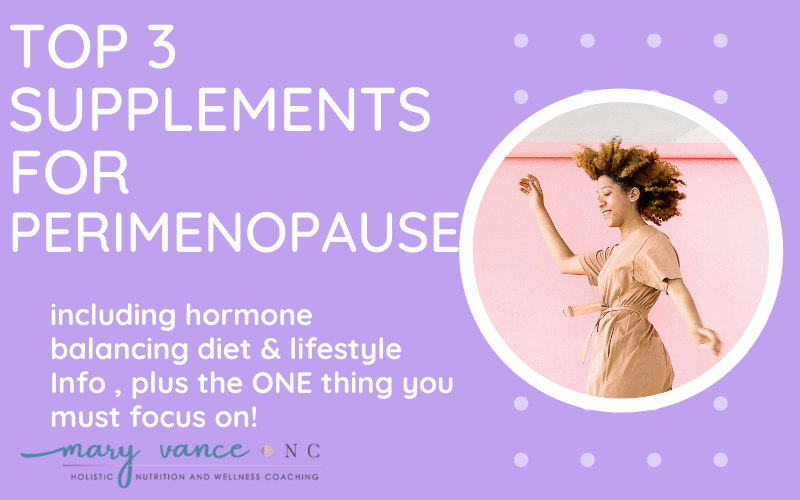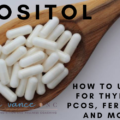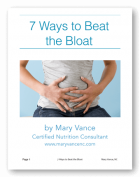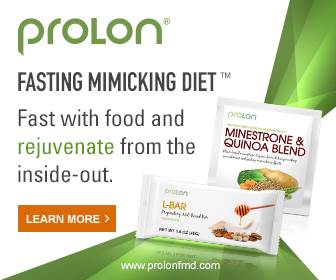Perimenopause, literally “around menopause,” is the transitional period leading up to menopause as hormone shifts begin. It is a time of hormonal decline as the body prepares to stop ovulating and shift into menopause, the end of a woman’s reproductive years.
During perimenopause you may notice subtle shifts, like changes in your cycle, or more dramatic symptoms like hot flashes that can be quite disruptive. This shift can last a few months to several years. Along with diet and lifestyle support, there are some wonderful supplements and herbs that can ease the perimenopausal transition. Below are my top three supplements for perimenopause.
What is Perimenopause?
Perimenopause encompasses the years leading up to menopause, anywhere from two to ten years, when estrogen begins to drop. The average age of menopause is 51, and perimenopause symptoms typically begin about four years before your final period. Most women start to notice perimenopause symptoms in their 40s.
The most common indication that you’re heading into perimenopause is irregular periods. Periods will continue to become more erratic until they disappear altogether. It’s not always a steady hormonal decline however; your hormones can drop and rise suddenly, and that’s when you notice more severe perimenopausal symptoms.
Moving into perimenopause means your ovaries stop producing as much estrogen and progesterone, your main reproductive hormones. This decline is what causes symptoms, and the more unbalanced your hormones are going into perimenopause, the more severe your symptoms are likely to be during perimenopause and menopause. So, your early 40s are a key time to really focus on your health and hormonal balance. Tune up your diet, address your stressors, fine tune your sleep hygiene, know your blood sugar levels, and get labwork (I discuss below).
In a typical 28-day cycle, your estrogen and progesterone levels rise and fall predictably. Midway through the cycle, ovulation happens, and menstruation begins two weeks later. (read about the phases of your cycle here). During perimenopause, however, hormones may not follow a set pattern, causing irregular cycles.
Progesterone, the hormone you need to get and stay pregnant, starts declining in your 30s, and this causes a shorter luteal phase (the second half of your cycle), so you may notice shorter cycles or trouble conceiving (if that’s your goal). Lower progesterone also causes sore boobs, spotting, low libido, headaches, and mood swings. Low progesterone in relation to estrogen can leave you estrogen dominant, which puts you at risk for hormonal cancers. Read more here.
Estrogen levels start dropping closer to perimenopause typically (note that you can still be estrogen dominant even with low estrogen and lower progesterone; it’s the ratio that matters) and is responsible for vaginal dryness, mood swings, and low sex drive.
Perimenopause Symptoms
- hot flashes
- a worsening in PMS
- night sweats
- irregular periods, shorter in duration or skipped altogether
- heavier periods
- depression, irritability
- insomnia
- irregular ovulation
- lower sex drive
- vaginal dryness
- weight gain, changes in body composition
The conventional medical approach is to recommend low dose hormonal birth control, which carries risks & side effects. Anti-depressants are often recommended to address mood swings. But on the more holistic side of things, we recommend testing to see what your hormones are doing (more on that below) along with herbs, supplements, and diet to help ease the transition. It is possible to make it through perimenopause pleasantly!
Top Three Supplements for Perimenopause
Google ‘supplements for perimenopause’ and you’ll likely get a laundry list, but I’ve narrowed it down to three (and change) for you. I’ve used these herbs and supplements myself and have recommended them to my perimenopausal clients consistently with the best results.
Maca is an amazing adaptogenic herb (a root, actually) that boosts vitality, libido, energy, and helps balance hormones moving into perimenopause. It may also decrease hot flashes. I noticed a huge improvement in my creaky joints and sleep when I started taking this herb. There are something like 16 different phenotypes of maca, so you want to make sure you choose the right one. I recommend the Femenessence maca, as it’s clinically proven to improve perimenopausal symptoms and support hormone balance, and they use the proper type of maca in each of their formulas. This one is formulated for perimenopause. It improves sleep, libido, vaginal dryness, hot flashes, and mood swings.
Natural progesterone support: For dropping progesterone levels that cause shorter cycles and heavier periods, you can try vitex AKA chasteberry which is a wonderful herb that balances the HPA axis and supports progesterone. Here’s my article on it. If you have tested your hormones and are certain your progesterone is low, you can use a bio-identical topical progesterone support like this. You apply a few drops to your arm during the second half of your cycle to support normal progesterone rhythm. This one can be a game changer, especially if you have the sore boobs, heavier cycle, and less time between periods (shorter cycles).
Evening primrose + essential fatty acids: this fatty acid formula is rich in gamma-linolenic acid which supports hormone balance (especially good for PMS) and skin health. Also helps with inflammation and the creaky joints that can surface as estrogen levels decline in perimenopause. Get it here.
It’s also worth mentioning that starting bio-identical hormone replacement therapy can support heart and bone health moving into menopause. You’ll need to work with a doctor or naturopath to prescribe the right combos for you, and you’ll need to test your levels regularly.
Extra Credit
Although the maca helps support sleep, if you are still waking in the middle of the night or having trouble sleeping, try passion flower. It’s pretty amazing for sleep, relaxation, and anxiety. Passionflower supports the activity of GABA, a neurotransmitter that aids in calming. If you’re feeling tired but wired and struggle to fall asleep (a common complaint amongst perimenopausal women), try this tincture. Keep it on your bedside and do a couple droppers full when you wake up in the middle of the night.
And for vaginal dryness: Try this cream. It’s excellent to combat vaginal dryness and thinning of vaginal tissue that precedes menopause. It soothes itching and revitalizes vaginal elasticity. May also increase libido.
I also recommend this cream for vaginal dryness. I alternate between the above and this one, which provides a little natural estrogen to prevent vaginal atrophy.
Finally, if you tend toward high blood sugar or blood sugar spikes that can worsen overall hormone health and perimenopausal symptoms, berberine can help lower and stabilize higher blood glucose levels. Read my article on it here (it’s pretty amazing; I take it myself). This is great for body composition changes and fat that starts to accumulate. Sadly, a common perimenopause symptom is sudden weight gain with zero changes to cause it (other than fluctuating hormones and blood sugar).
Perimenopause Labwork Checklist
If you’re not staying on top of your lab work, now is the time. You want to check hormone levels heading into perimenopause, especially thyroid, blood sugar, and lipids. Knowing these numbers will help you determine how to adjust your diet and support your hormones. You can order these labs here yourself.
Your doctor will likely tell you that testing hormone levels is useless if you’re moving into perimenopause, but this isn’t the case. Knowing your estrogen, DHEA, testosterone, and progesterone levels can help your practitioner design a protocol to ease your symptoms. I recommend the DUTCH saliva test (you can order it from this menu) which gives you a lot of data about your hormone levels. It will also give you info about “good” and “bad” estrogen levels. If your “bad” estrogen levels are too high, for example, you could be at an increased risk of breast cancer and can take steps now to mitigate that risk. You’ll need a practitioner to help you analyze the results.
You can also do the women’s health panel from EverlyWell. Order it via this link which gives you a discount, then search for women’s health test.
Check These Markers
Fasting glucose: blood sugar naturally rises as we age and especially during perimenopause, and that’s a cause of weight gain. You want fasting glucose to be around 85mg/dL. Any higher than 99 mg/dL means you want to adjust your diet so you don’t approach pre-diabetes range, which puts you at risk for a number of diseases.
HbA1C: a measure of your blood glucose over the past 3 months. You want it to be around or just under 4.9%.
Lipid panel includes triglycerides & cholesterol. See this post for more on optimal ranges.
Thyroid panel is vitally important for women in their 40s. See this post for optimal ranges. If your thyroid is out of whack it affects all your hormone levels and will lead to weight gain and worsen perimenopausal symptoms. Ask for a FULL thyroid panel including TSH, free T3, free T4. Most doctors will only run TSH which isn’t enough.
FSH/LH: follicle stimulating and luteinizing hormone levels will tell you how far you are into perimenopause or menopause. Dropping estrogen causes FSH to rise. An FSH level of > 30 IU/L is consistent with the perimenopause,
Diet & Lifestyle Support
The main issue I encounter with women in perimenopause by far is weight gain, especially around the midsection. Add fatigue to that, as sleep becomes disrupted. Both of these issues are rooted in blood sugar regulation along with fluctuating hormone levels. As we age, the pancreas produces less insulin which means blood sugar remains elevated longer, and elevated blood sugar translates into weight gain over time. The ONE THING to focus on in perimenopause is lowering and maintaining stable blood sugar.
There’s some fairly good research supporting a lower carb diet for perimenopause. Reducing carb consumption in the form of grains, sugars, and alcohol may decrease insulin levels and improve hormonal imbalances, decreasing perimenopausal symptoms and supporting fat loss. A modified ketogenic diet may work well for stubborn fat loss. (Note that I do not recommend a classic keto diet for women). A lower carb diet can really support blood sugar levels and prevent the spikes that occur when you eat too many grains or white flour foods.
Focus on an anti-inflammatory diet (read how here) with plenty of lower carb (crunchy, leafy) veggies, good fats, and anti-inflammatory proteins like wild salmon & seafood. Including phytoestrogenic foods like flax may support dropping hormone levels. Avoiding alcohol may mitigate hot flashes.
Aside from what you’re eating, support blood sugar by focusing on a daily routine where you eat in regular intervals, wake up and go to bed at the same time, practice good sleep hygiene, get bright sunlight first thing in the morning to support circadian rhythm. If you continue to struggle with weight gain or fat loss, consider a glucose monitor to help you determine which foods may be spiking your blood sugar (it can even be “healthy” foods like gluten free grains, legumes, or sweet potatoes). The goal is to maintain steady blood sugar during the day.
Check out Sara Gottfried’s book Women, Food & Hormones for more about hormones in perimenopause and how a modified keto diet can help.
Want Support for Perimenopause?
I work with many women on the transition to perimenopause and menopause. I can help you support hormone balance and determine the right diet for you to help you feel your best during this time. Apply to work with me here.
Pin it!

Mary Vance is a Certified Nutrition Consultant and author specializing in digestive health. She combines a science-based approach with natural therapies to rebalance the body. In addition to her 1:1 coaching, she offers courses to help you heal your gut and improve your health. Mary lives in San Francisco and Lake Tahoe in Northern California. Read more about her coaching practice here and her background here.










I am postmenopausal with levels that aren’t too abnormal but have no uterus left. But am going through menopause very strongly and feel horrible between my night sweats, hot flashes , nausea, diarrhea and fatigue and achy joint and muscles. Don’t know what to do. My surgeon refused to remove my ovaries and now no HRT three years and lost two inches in height.